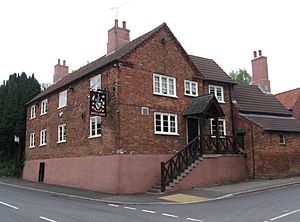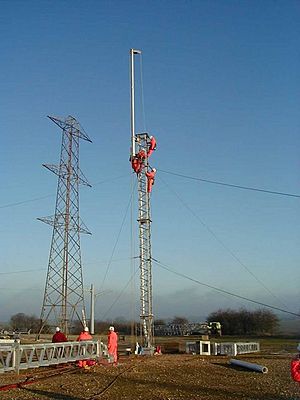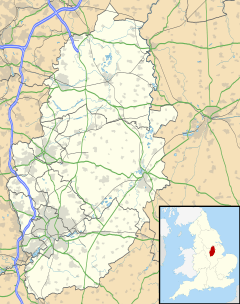Eakring facts for kids
Quick facts for kids Eakring |
|
|---|---|
| Village and civil parish | |
 Eakring – Savile Arms |
|
Parish map |
|
| Area | 4 sq mi (10 km2) |
| Population | 440 (2021) |
| • Density | 110/sq mi (42/km2) |
| OS grid reference | SK 673623 |
| • London | 120 mi (190 km) SSE |
| District |
|
| Shire county | |
| Region | |
| Country | England |
| Sovereign state | United Kingdom |
| Post town | NEWARK |
| Postcode district | NG22 |
| Dialling code | 01623 |
| Police | Nottinghamshire |
| Fire | Nottinghamshire |
| Ambulance | East Midlands |
| EU Parliament | East Midlands |
| UK Parliament |
|
Eakring is a small village and civil parish located in the Newark and Sherwood area of Nottinghamshire, England. In 2021, about 440 people lived there. Eakring is also known for a time in the mid-1900s when a lot of oil was found and produced there.
The name Eakring comes from an old language called Old Norse. It means "the circle of oak trees", which sounds like a nice place to live!
Contents
Exploring Eakring's Location
The village of Eakring is found between two main roads, the A617 and the A616. These roads connect it to other towns like Ollerton and Southwell.
South of the village, there's a place called Dukes Wood. It sits on top of a high ridge, which gives amazing views. From here, you can see across the Trent valley to the east and towards Southwell in the south.
Eakring's History and Landmarks
Eakring has some interesting old buildings and a long-distance walking path.
Village Pub and Footpath
The local pub in the village is called the Savile Arms. It's on Bilsthorpe Road. If you like walking, the Robin Hood Way footpath goes right through Eakring. This path is super long, stretching for about 168 kilometers (104 miles)!
Old Windmills of Eakring
There was once a tall brick tower windmill in Eakring, built after 1840. It had five floors! The big sails were taken off in 1912, and by 1936, it was no longer used. Around 1995, it was turned into a house.
Other old maps also show windmills in different spots around Eakring from the 1800s.
St Andrew's Church
The main church in the village is called St Andrew, named after one of Jesus's first followers. This beautiful building was built a very long time ago, between the 1200s and 1400s. It was fixed up in the 1880s, and new seats were added.
Inside, you can see a special font (a basin for baptisms) from 1674. There's also a plaque that remembers when the church tower clock was put in, back in 1887.
The Old Rectory
In the early 1700s, a man named Gilbert Michell was the Rector (a type of priest) in Eakring. The house he lived in, now called the Old Rectory, was the biggest house in the village at that time. It had a large barn, other buildings, and even two fish ponds that were used for fun!
Famous People from Eakring
Eakring has been home to some notable people:
- Reverend William Mompesson: He was a vicar in another village, Eyam, during the Great Plague in 1666. He moved to Eakring in 1670 and lived there for 39 years. He is buried in the churchyard.
- John Michell (1724–1793): Born in Eakring, John was a clever thinker who studied nature. He made important discoveries in areas like space, rocks, light, and gravity.
- Helen Cresswell (1934–2005): Helen was a very busy writer, especially known for her books for children. She passed away at her home in Eakring in 2005.
Eakring's Secret Oil Production in World War II
During the Second World War, Eakring played a secret and very important role in helping Britain get oil.
Finding the Oil
In the late 1930s, a company called D'Arcy Exploration Co Ltd (which is now part of BP) started looking for oil. They used information from coal mines to figure out that there might be oil hidden deep underground in Eakring. They had already found oil nearby in a place called Kelham.
When they drilled deep, they found a lot of oil! This discovery became super important when World War II started and German submarines (U-boats) made it hard to bring oil into Britain by ship.
Drilling for Oil
Oil wells were set up in Eakring, Caunton, and Kelham Hills. The oil they found was of a very good quality. Britain usually didn't have much oil of its own, so this was a huge help.
In March 1943, oil production began with about 100 wells. An engineer named Philip Southwell worked with an American company to get things going. During the war, the oilfield produced millions of barrels of oil using 170 pumps, sometimes called "nodding donkeys" because of how they moved.
The oil production continued until 1964. The location of these oil wells was kept a secret throughout the war. American oil workers who helped with the drilling lived at a special college called Kelham Hall.



